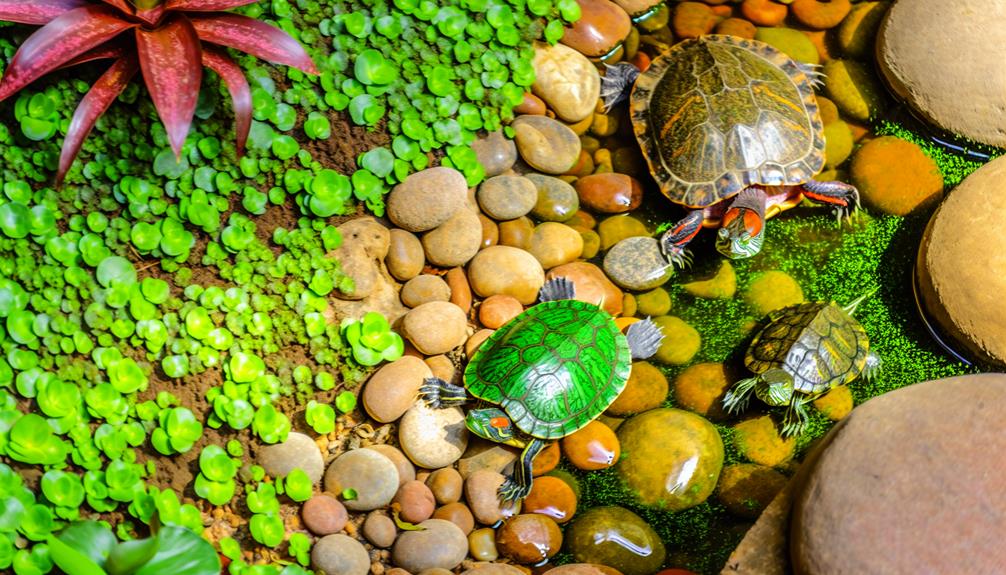When considering the best turtles for beginners, the Red-Eared Slider stands out for its vibrant colors and engaging personality, requiring a 40-gallon tank. Box Turtles, with their unique shell structure, thrive in terrestrial environments and need varied diets with proper humidity. Painted Turtles are visually appealing and require a spacious aquarium with maintained water temperatures. Snapping Turtles demand commitment due to their powerful jaws and aquatic needs, while Softshell Turtles, known for agility, require generous tank space and high-quality filtration. Each species offers unique traits and care requirements that are essential to understand before getting started.
Key Takeaways
- Red-Eared Slider Turtles are vibrant and engaging, requiring a minimum 40-gallon tank and basking areas with heat lamps for temperature regulation.
- Box Turtles have unique shells and need terrestrial enclosures with hiding spots, a varied diet, and appropriate humidity levels for healthy living.
- Painted Turtles are visually appealing, needing a spacious 40-gallon aquarium with maintained water temperatures and regular water changes for optimal health.
- Snapping Turtles have powerful jaws and require clean, warm water with a basking area, alongside a diet consisting of fish and insects.
- Softshell Turtles feature leathery shells, thrive in a minimum 75-gallon tank, and need high-quality filtration and UVB lighting for overall health.
Red-Eared Slider Turtles

Red-Eared Slider Turtles are among the most popular pet turtles, known for their vibrant colors and engaging personalities. These turtles are highly social creatures that thrive in a well-maintained environment, making them an excellent choice for both novice and experienced pet owners. Understanding their red eared care and habitat requirements is essential for promoting their health and well-being. Research has shown that providing a stimulating environment can considerably enhance their learning and adaptation skills, akin to the principles of adaptive learning technology.
In terms of habitat, Red-Eared Sliders require a spacious aquarium or pond that mimics their natural environment. A minimum tank size of 40 gallons is recommended for adult turtles, along with adequate filtration to maintain water quality. They also need basking areas with a heat lamp to regulate their body temperature and dry off.
Diet is another critical aspect of red eared care. A balanced diet consisting of commercial turtle pellets, fresh vegetables, and occasional protein sources like insects or cooked fish is crucial for their growth and vitality.
Box Turtles
Box Turtles are a fascinating choice for pet enthusiasts, distinguished by their unique shell structure and terrestrial lifestyle. Unlike aquatic turtles, box turtles prefer to roam on land, making them an ideal companion for those who enjoy interactive pet experiences. Their domed shells provide excellent protection, allowing them to retreat into their shells when threatened. Additionally, box turtles exhibit a range of personalities and behaviors, which can enhance your interaction with them and lead to a stronger bond over time. This is similar to how effective social skills can enhance connections with others.
Proper box turtle care is vital for their well-being. A varied diet of leafy greens, fruits, and commercial turtle pellets will keep them healthy. It's important to guarantee they have access to clean, fresh water for hydration.
Creating a suitable box turtle habitat is equally important. A spacious enclosure with plenty of hiding spots and places to burrow will help mimic their natural environment. Incorporating substrate like coconut fiber or mulch allows them to dig, which is a natural behavior for these turtles. Additionally, maintaining appropriate humidity levels and providing a basking area with UVB light will help them thrive.
Ultimately, owning a box turtle can be a rewarding experience that fosters a deep connection between you and your pet, as you nurture their needs and watch them flourish in a carefully crafted habitat.
Painted Turtles

Painted Turtles are among the most vibrant and visually appealing turtle species, making them a popular choice for pet owners seeking an enchanting aquatic companion. Their striking colors and patterns can create a mesmerizing atmosphere, similar to how the best flying mounts enhance exploration in games like Palworld. However, prospective owners should be well-informed about their care requirements to guarantee a thriving environment for these beautiful reptiles.
Painted Turtles require a spacious habitat setup that mimics their natural environment. A large aquarium is essential, ideally with at least 40 gallons of water. This not only provides ample swimming space but also allows for the installation of a basking area, where they can comfortably sunbathe. The water temperature should be maintained between 75°F and 80°F, while a basking spot should reach around 85°F to encourage healthy behaviors.
In addition to the right temperature, it's vital to filter the water to keep it clean and clear. Regular water changes will also contribute to a healthier living space. With proper care and an engaging habitat, Painted Turtles can be rewarding pets, offering their owners a vibrant connection to nature.
Snapping Turtles
Snapping Turtles are a fascinating alternative for those interested in keeping a more robust and unique species. Known for their powerful jaws and distinctive appearance, these turtles require special considerations in their care and habitat. Understanding snapping turtle care is essential for anyone looking to provide a suitable environment for these creatures. As with any pet, staying informed about their needs is fundamental, especially when considering the latest trends in pet ownership, such as new games and entertainment.
Snapping Turtles thrive in a variety of aquatic habitats, including ponds, lakes, and rivers. They prefer areas with abundant vegetation and submerged structures, which provide both shelter and hunting grounds. When setting up a habitat, make sure that it includes clean, warm water, as well as a basking area where the turtle can dry off and absorb sunlight.
Feeding these turtles requires attention to their dietary needs, which can include fish, insects, and plants. Regular monitoring of water quality and temperature is essential, as these factors directly impact their health and well-being.
While snapping Turtles can be intriguing pets, they demand a commitment to proper care and a suitable habitat. If you're ready for the challenge, they can be a rewarding addition to your home, offering a glimpse into the wild side of nature.
Softshell Turtles

Softshell Turtles, characterized by their unique leathery shells and streamlined bodies, are an intriguing choice for pet owners seeking a distinctive aquatic companion. These turtles are known for their agility in water and can be a fascinating addition to any home aquarium. However, understanding their specific needs is vital for successful softshell care.
To guarantee a healthy environment for your softshell turtle, it is important to meet their habitat requirements. Below is a table outlining key factors to take into account when setting up their living space:
| Aspect | Requirement | Notes |
|---|---|---|
| Tank Size | Minimum 75 gallons | Larger tanks are better |
| Water Temperature | 75-85°F (24-29°C) | Use a reliable heater |
| Filtration | High-quality filter | Maintains water quality |
| Substrate | Sand or smooth gravel | Prevents shell abrasions |
| UVB Lighting | Essential for health | 10-12 hours daily |
Frequently Asked Questions
What Is the Average Lifespan of Pet Turtles?
The average lifespan of pet turtles varies considerably among different turtle species. For instance, smaller species like the red-eared slider can live around 20-30 years, while larger species such as the Aldabra tortoise may exceed 100 years. Proper pet care, including a suitable habitat, diet, and regular health checks, is essential for maximizing their longevity. Understanding the specific needs of each species can enhance both the well-being of the turtle and the owner's experience.
How Much Space Do Turtles Need in Their Habitat?
When considering the habitat size for turtles, it is vital to recognize their specific water requirements and overall space needs. Generally, aquatic turtles require at least a 40-gallon tank, while larger species may necessitate even more room. Additionally, a designated basking area is important for their health. Ensuring adequate space not only promotes their well-being but also enriches their environment, fostering a deeper connection between the turtle and its caregiver.
Do Turtles Require Special Lighting or Heating?
Turtles indeed require special lighting and heating to thrive, as they are ectothermic animals. A proper habitat setup should include UVB lighting to support their shell and bone health, mimicking natural sunlight. Additionally, maintaining a warm basking area is essential for digestion and overall well-being. Coupled with a balanced turtle diet, these environmental factors guarantee a healthy lifestyle, fostering a sense of belonging and care for your pet turtle within your home.
Can Turtles Be Kept Together in the Same Tank?
When considering if turtles can be kept together in the same tank, it is essential to acknowledge their territorial behavior. Some species may exhibit aggression towards potential tank mates, leading to stress or injury. It is advisable to house turtles of similar size and temperament to minimize conflict. Additionally, providing ample space and hiding spots can help reduce territorial disputes, ensuring a more harmonious environment for your aquatic companions.
What Are Common Health Issues in Pet Turtles?
Common health issues in pet turtles often stem from inadequate turtle nutrition and improper shell care. A poor diet lacking essential vitamins and minerals can lead to metabolic bone disease, while neglecting shell hygiene can result in shell rot or infections. Observing your turtle's eating habits and maintaining a clean habitat are vital for preventing these ailments. Regular veterinary check-ups can also help guarantee your pet's well-being and longevity.




